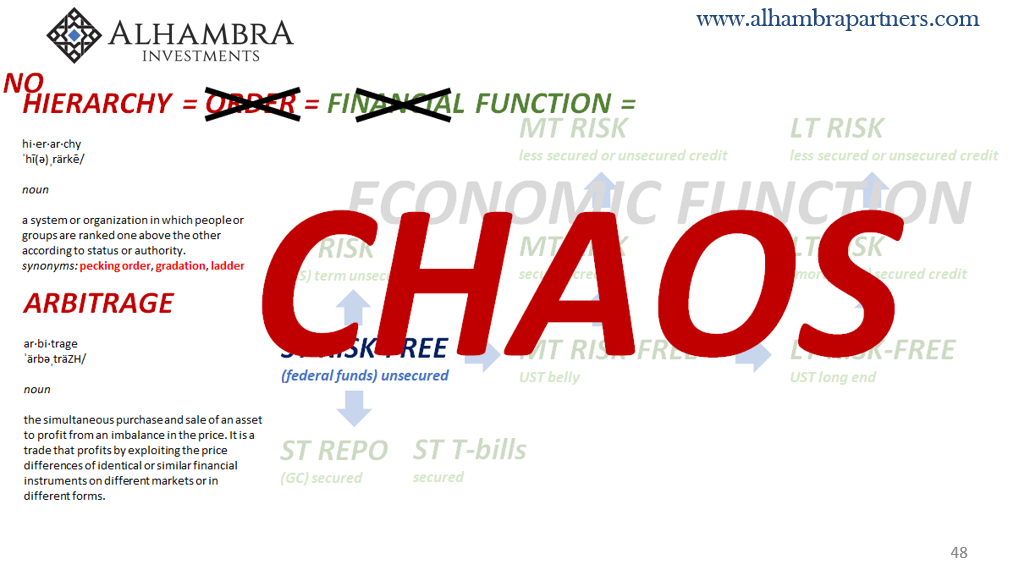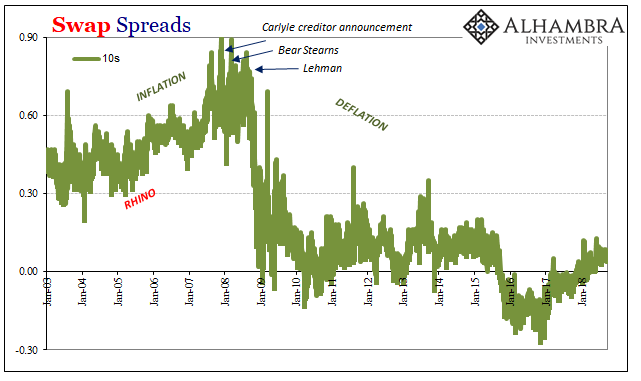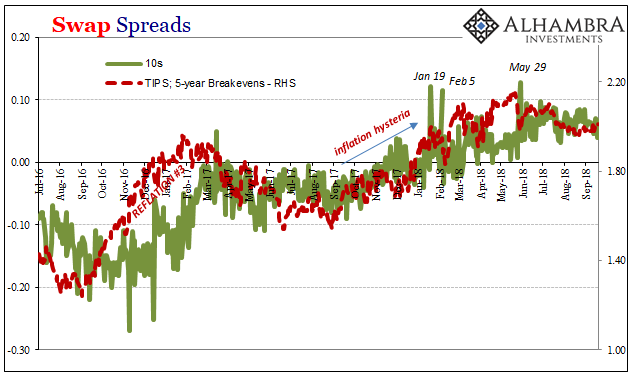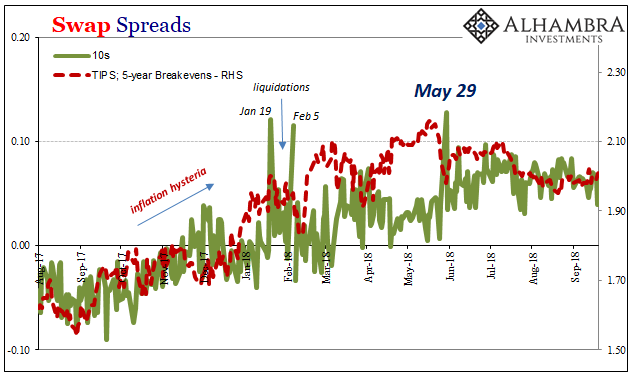In June 2003, while discussing the vote that would take the federal funds rate to its then-lowest point, 1%, Alan Greenspan committed what may have been the greatest monetary sin of modern times. The focus for much of the discussion was Japan, that country’s central bank pioneering at that early date all the things the Fed and other majors would do later. It wasn’t working, and some American officials, including Greenspan, were unnerved.
CHAIRMAN GREENSPAN. One is that I don’t think we know enough about how the private financial system works under these conditions. It’s really quite important to make a judgment as to whether, in fact, yield spreads off riskless instruments—which is what we have essentially been talking about—are independent of the level of the riskless rates themselves. The answer, I’m certain, is that they are not independent.
This is not a small, trivial matter. As it would turn out, everything hinged on whether or not he was right. Unfortunately for the world, he wasn’t.
The nuts and bolts of this issue were the basis for my talk in Toronto the day after the eleventh anniversary of August 9, 2007. I’ll post the video for it in the coming days.
The short version is this: the central bank is central and therefore dictates monetary hierarchy. This is the lack of independence the “maestro” was certain about. Predictable monetary hierarchy is the basis for monetary policy’s intended predictable influence on the economy. Hierarchy is order; the lack of it equals, well, chaos.


Just one day after August 9, his certitude, which his successor Bernanke possessed in far greater supply, was shattered. Money rates began to move independently and the system has never gone back.
The most embarrassing and egregious illustration of this breakdown came in federal funds itself. The effective rate just wouldn’t respond to any central bank inputs. It’s still misbehaving to this day.
One of the more obvious examples was interest rate swaps. An interest rate swap is an exchange of liabilities between financial counterparties. It entails risk. Therefore, pace Greenspan, the pricing of that swap (quoted as the fixed leg) should begin at the risk-free rate. At maturities, that would mean the UST yield.
For a 10-year swap, the fixed leg should cost the equivalent 10-year yield plus a spread. That spread, known as the swap spread, tells us a lot about the deeper internals of the fixed income system. Wall Street’s presumed affection for stocks gets all the media attention, but it has always been “bonds” that have run the place.
If Greenspan was right about independence, there would be no way for the swap rate in any maturity to price less than its equivalent UST yield. What would that, this negative swap spread, say about the state of the world? On its face, it would seem to suggest the market is pricing lower risk for the financial counterparties undertaking them than the risk-free US federal government. How can you add up to less risk than risk-free?
This did happen, though it took longer to develop than other breakdowns in market hierarchies. The swap market was, in fact, one of the last indications of massive crisis in balance sheet capacity that broke out only starting August 9, 2007.

What that means is swap spreads do a very good job telling us “what” if not always “when.” Given what they are, interest rate swaps follow in close relationship to inflation expectations. Inflation, as a component of future economic growth potential, is an integral piece of the fixed income guts of the global system.
A negative swap spread is essentially meaningless at least in the traditional mechanics of prior history. It didn’t actually mean the market looked at the federal government’s debt more negatively, the negative spread really had little to do with UST’s at all. And that’s the point, this sudden “independence”. It simply meant the “maestro” had it all wrong – and therefore the dire consequences for the system as central bankers keep committing, and commitment to, this huge mistake.

The history of the last eleven years shows persisting low and occasionally negative spreads for interest rate swaps (with the 30-year maturity spread being negative almost the entirety of the last ten years, only breaking positive for a time during Reflation #2). Again, what if not always when.
Which brings us to 2018. Spread decompression had been consistent with at least the direction of reflation. Reflation #3 in terms of market rates never really got going all that robustly, which matches the economy and monetary assessments of a lot of other indications. Banks offered a little more capacity but not much more.
The movement in swap spreads had followed the movement in inflation expectations as a consequence – which would be expected. If there was going to be one thing that would change everything, a return toward normalcy meaning actual recovery, it would be an inflationary signal that opportunity in the real economy had returned. The scourge of tight money would be lifted and life might go back to normal.
In reality, “bond” markets which interest rates swaps are a huge part weren’t really pricing much of a chance for that happening. They merely went from it being near impossible at the depths of 2016 to becoming slightly less impossible at the best point earlier this year.

That was the direction, anyway, until May 29. Since the massive, incomprehensible collateral call that day (and in the weeks leading up to it), swap spreads all down the curve have been slightly compressed again. The 5-year spread, for example, was the smallest this week since mid-May.
This is contrary to the signal being put out by the UST market’s latest BOND ROUT!!! Nominal yields are rising, but unlike last year there isn’t a reflation basis to them. And it goes back to May 29.

This may be nothing more than a temporary trend, we’ve seen them before. And, to reiterate for a third time, swap spreads are not always timely in how they move around.
Still, it’s noteworthy the difference before and after. There were at least mild reflationary tendencies prior in the tepidly decompressing spreads like slightly rising inflation breakevens. Not this time.

If we go by just the “what” part of it, it seems to suggest the bond market is responding to the things central bankers might do not why they will do them. Jay Powell in the US, like scared taper in Japan, is almost certainly going to continue his exit but for reasons these markets don’t appear to share. Not now.
Further and intermittent breakdowns in hierarchy have tended to cluster together this way. I’ve noted some big ones before, the repo rate and its relationship to federal funds or the RRP “floor.” In effective eurodollars, this is renewed tight money, the gathering data for a fourth episode of it.
The difference in nominal UST yields, as opposed to the flattening yield curve which is acting consistent with swap spreads, is simply that like 2008, 2011, or 2015, the Fed doesn’t know why it’s tight money. This is very different than “rate hikes” or QT, neither of which would explain the breakdown in hierarchy – because the breakdown in hierarchy once again proves the central bank is a passenger on the global money train not its conductor.
In other words, not only have rates become autonomous in this elongated eurodollar decay, the central bank is, too, entirely independent from the money market. Policymakers still don’t realize it.
If Powell were anywhere close to being right, the swap market like the Treasury market would be massacred. It’s nothing like that. Since May 29, we’re back to more comprehensively shaming Greenspan again.


Stay In Touch